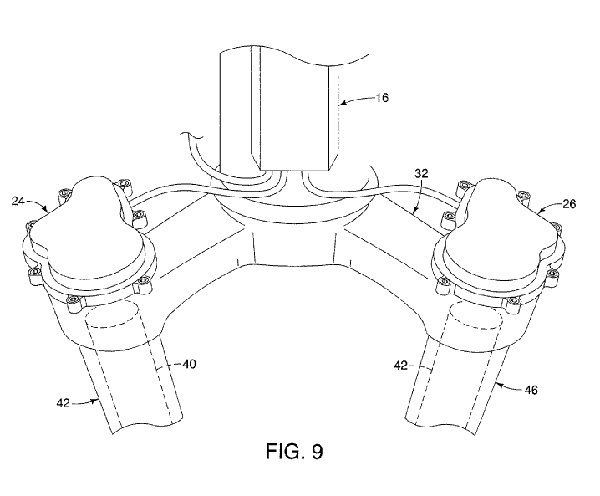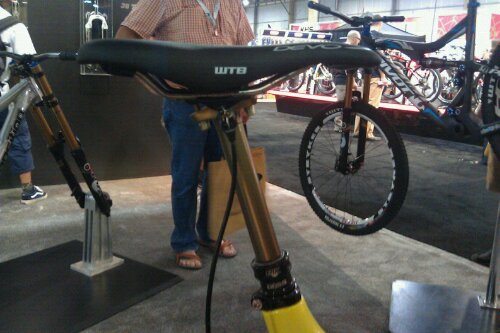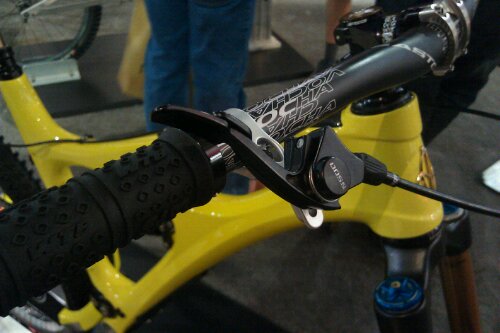It seems I haven’t been the only one to notice Shimano’s steadily accumulating arsenal of game-changing patents lately. Matt Wiebe’s new article in Bicycle Retailer draws attention to the industry behemoth’s patent portfolio, which dwarfs the competition. Wiebe writes that Shimano “is moving into areas of development—dirt suspension, hydraulic rim brakes, dropper seatposts and electric integration—that could shake up the market if the technology makes it into production.” Absolutely. And you don’t build an empire on your production capabilities by applying for patents for stuff you never intend to make. By all indications, Shimano is about to deliver their second major industry shakeup, and things are about to get rough for SRAM.
Or maybe not.
Much is constantly made of the relationship between component manufacturers and bike companies. The Bicycle Retailer article rightly points out the market share SRAM had been gaining in bundling suspension and components for OE spec on bikes, and the conspicuous silence from Shimano regarding this. “A survey of suspension engineers, who declined to go on record, said Shimano has the technology to make competitive forks,” writes Wiebe, “but none thought the company was setting up to enter the market. At the same time, however, they wonder how long Shimano can stand on the sidelines as SRAM’s RockShox suspension line enables it to offer product managers seductive pricing on component and suspension packages.”
The article goes on to point out that Shimano’s continuing absence from the suspension market continues to offer “a lifeline for Fox, Manitou, Marzocchi, SR Suntour and others,” which is true, except that one of those brands is clearly not like the others. Shimano doesn’t share patents with Marzocchi, Manitou or any also-ran suspension companies the way they do with Fox. The recent high-profile move of the Santa Cruz Syndicate team from SRAM to “Shimano and Fox,” combined with some pretty clear writing on the patent walls makes one thing pretty clear.
Shimano is going to buy Fox.
That is, if they even need to. Plenty of business mechanics to compute there, and clearly both companies are already benefiting from a very close partnership that might not require actually tying the corporate knot, but the writing is clearly on the wall.
Manitou and Marzocchi? Yes, they’re doomed. What’s left of them, at least. But SRAM? I don’t think so.
Continued and even strengthening relationships between Fox and Shimano will certainly not be good for SRAM, but SRAM has what it takes to survive the assault, and stands to benefit from the attrition that’d take place in the suspension market. Already borderline non-existent in the OE market, Manitou and Marzocchi’s potential total extinction stands to benefit SRAM’s RockShox division, a company with a far wider assortment of suspension products across a wide price range–much wider than Fox. A full assault by the combined Shimano and Fox forces would make what’s been happening over the past decade offical: nobody would be left but SRAM.
And somehow, White Brothers. Have to hand it to those scrappy little guys.
SRAM’s suspension products still need both brand work and innovation before they can truly rival the industry reputation and near rear suspension monopoly that is Fox, but SRAM has made tremendous headway in paying attention to the end user. When Shimano notoriously “integrated” your shifting and braking on mountain bikes, SRAM very specifically did not. SRAM has also led the way in 2×10 mountain drivetrains, a “by the people, for the people” kind of revolution. In both cases, SRAM’s marketing did an outstanding job of delivering the message: “We know what you want, and we’re building it for you.” They used Shimano’s enormous weight against them, getting the big guys off balance in the eyes of the public. Behind the scenes, this was a blip on Shimano’s bottom line, but SRAM set up shop inside that market inflection point and carved out a huge name for themselves.
It’s going to come down to electronics. If Di2 is any indication, Shimano may have already won the war, but it’s also possible that we’ll see a backlash to electronics among riders out there. SRAM has already drawn a line in the sand when it comes to road groups. Want to save a pound and a half? You know where find us. Adoption of electronics on mountain bikes could be more complicated–especially if Shimano plans to have a battery operating everything from your shifting to your suspension damping. Picture the entrance of a Shimano/Fox electronically controlled suspension fork onto the market with a price tag over $1000. How would that be received? How would it be promoted?
Interesting stuff. One thing is certain, though. If I were SRAM’s marketing department these days, I’d be putting a lot of effort into grassroots racing support and features the average rider can clearly appreciate–and I wouldn’t be pushing the panic button just yet. People still like alternatives. If SRAM can maintain their image as the best alternative, that’s good enough. It’s like the old “outrunning a bear” thing: SRAM doesn’t have to be faster than Shimano/Fox; they just have to be faster than all those delicious little companies who are much slower than they are. What looks like a vicious war between Shimano and SRAM might turn out to be pretty painless for both companies, but completely devastating to everybody else.








